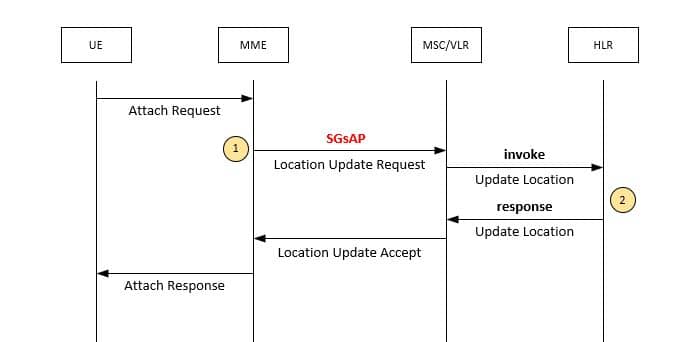CSFB makes circuit switched (CS) services (e.g. voice calls) in a LTE enabled networks. To receive or initiate a CS service, the subscriber or user is temporarily move to the 2G/3G network and re-attach to LTE afterwards. In the following sections we will describe or detailed the CSFB call-flow.
In a LTE enabled network, the UE attach to an eNB and with the combined EPS/IMSI attach the UE registers to the 3G network indicating support for CSFB and MME selects MSC/VLR for the CSFB procedure. While in this situation, MME keeps the 3G network updated about the location and will be used for paging procedure from 3G to LTE during a call. During a call (e.g. voice call), the UE is detach from the LTE and attach to 3G.
To illustrate the flow a bit deeper:
- Tracking area and Location area mapping is define in the MME and used to select the MSC/VLR for the CSFB procedure. Once the MSC/VLR is selected via the SGsAP Location-Update-Request is sent to the MSC/VLR. The request contains MME Name, User state (i.e. IMSI attach), TMSI status, etc.
- MSC/VLR performs the 3G Location Update Procedure, store the associated MME for the subscriber and respond to MME Location Update request.

CSFB - Mobile Terminating
- In a mobile-terminating call the GMSC will start interrogation procedure (i.e. locate the called user in the network). GMSC will initiate SendRoutingInformation-Invoke (SRI) towards the HLR. SRI is a MAP operation code.
- If the user is provided with CAMEL Service, the two-step interrogation is applied. in first interrogation, HLR will use the MAP Operation PSI (ProvideSubsriberInfo-Invoke) to request the VLR the subscriber location. The addressed VLR is the last known location of the subscriber mobility data. In response (PSI-response) VLR will provide location information (e.g. CellId)
- In the SRI response to GMSC, HLR will include the location information and the CSI information which is the T-CSI (Termination Camel Information).
- GMSC will try to open a Camel dialogue towards the SCP (Service Control Point). SCP will check the if the subscriber is allowed to received the MTC call. If yes, SCP will instruct the GMSC to monitor the call and report every calling state.
- Second interrogation is to request a roaming number towards the MSC/VLR using the MAP operation code ProvideRoamingNumber (PRN). The GMSC will sends an IAM with called-party-number = MSRN (Mobile Station Roaming Number). In the CS core network, every MSC/VLR has it’s own MSRN range. MSRN is E.164 format.
- The MSC sends a Paging-Request over the SGs interface, indicating CS call. MME will use the IMSI to find the S-TMSI which will be used as the paging address over the radio interface.
- MME relays a CS Service Notification to eNB and Service-Request message to the MSC/VLR. Service-Request message will contain TAI (Tracking Area Identity) and E-UTRAN CGI.
- The eNodeB will send Extend Service Request indicating that the service notification is accepted for MT CS Fallback. MME sends UEContextModificationRequest indicating cs-fallback-required meaning eNodeB should move the UE to 3G (or 2G) using the LAI allocated by MME earlier.
- eNodeB to issue UEContextReleaseRequest which mean PS-service will not be available in the CSFB target cell
- UE is moved to 3G for call termination (MTC)

CSFB - Mobile Originating
- The eNodeB is signaled that user wants to make a call. The eNodeB via S1AP message sends Extended Service Request containing service type=MO CS Fallback. MME will then respond UEContextModificationRequest to say that the service requested requires CSFB (cs-fallaback-required). After responding to the context modification request, eNodeB will issue a S1AP message – UEContextReleaseRequest to release the EPS session which mean PS services will not be available in the CSFB target cell.
- MME send ReleaseAccessBearerRequest to S-GW
- UE move to the target RAT and chooses a cell using the LAI received from the combined EPS/IMSI Attach/TAU accept message.
- CS Fallback is complete and network to proceed further with the voice call setup.

Hope this short write-up gave an insight on the related subject.
Feel free to drop a message anytime. Remarks and comments are all welcome. Visit us from time-to-time for new articles/topics

Although more than 20years working on Mobile Telecommunications – Core Network. Always wanting to learn and try new things.